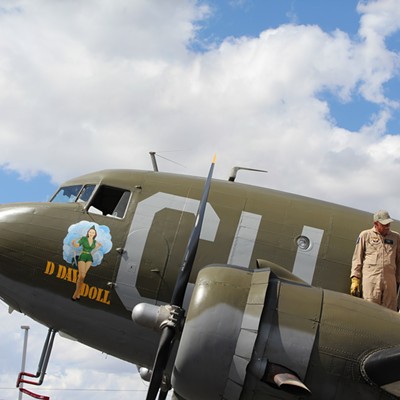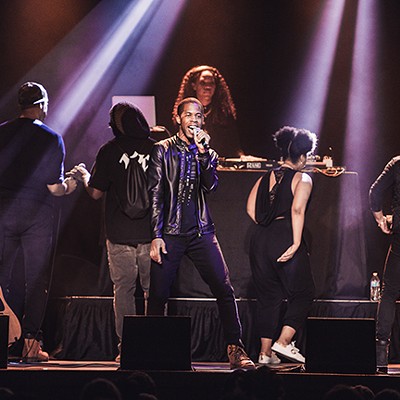The lady hails from Nayarit on the west coast of Mexico. Made between 200 B.C. and 300 A.D., she may be 2,000 years old or more, just one of the jewels in the Tucson Museum of Art's pre-Columbian crown.
This Saturday, the museum will reopen to the public its collection of pre-Columbian art, along with its fine holdings in Spanish Colonial and Postcolonial art, and 20th-century Latin American arts and crafts. The opening marks the debut of the museum's newest exhibition space, the Palice Pavilion of the Art of the Americas, TMA's first-ever permanent gallery devoted exclusively to historic regional art.
"Having a permanent display that relates to the history of this region is really important," says Joanne Stuhr, the TMA curator who gets credit for the elegant installation in the sprawling 1866 adobe house, which was successively owned by Duffields and Fishes and Stevenses. Until now, the works in the pavilion have been on display only intermittently. "The historic property makes a wonderful setting. The intimacy relates to the scale of the objects. I think this will be a big attraction. It will be very popular with school groups.
"People have already told me: This is the place where they'll send visitors."
Stuhr has made a roughly chronological arrangement of the objects in the building's many small rooms, all of them graced by wooden floors, latillo ceilings and thick adobe walls. Visitors will enter at the far southern door, where tiny rooms that once housed the offices of Janos restaurant now shelter the oldest pre-Columbian pieces. All around the "Seated Female" are fellow figurative pieces of pre-Columbian art in stone and ceramics, from a companion "Seated Male Shaman Effigy" from the same period in Nayarit to a standing ballplayer from Jalisco about to toss his pre-Columbian ball. The ball game, popular throughout the pre-Columbian world, even as far north as Tucson, gets its own display case, with sample objects from a variety of cultures.
The very oldest pieces in the collection are from the Chavín culture in the Peruvian Andes; a carved ritual bowl with a fanged deity and a human effigy may be as much as 2,500 years old.
"A tremendous amount has survived," Stuhr says of the pre-Columbian art. "The ceramic and stone materials are virtually indestructible."
Around a bend are pre-Columbian animals, a case of Mayan objects and a whole room devoted to geometric patterned textiles, miraculously preserved in the humid climes of Peru.
"The pre-Columbian textiles will be changed every six months," Stuhr says. They are susceptible to light damage and so they are displayed under motion-detector lamps to limit their exposure to artificial light. The fabrics hang on the walls of what was Janos' bar.
The Spanish Colonial period begins with the conquest of the Aztecs by Cortés in 1519 and the conquest of the Incas by Pizarro in 1531. Stuhr has organized a period room of decorative arts, including silver and furniture, in one room, and she's created a chapel, complete with niches, in another.
"There was so much production for religious purposes that I wanted the suggestion of a church altar," she explains, gesturing toward the carved sculptures of angels and saints.
In the central zaguán, or breezeway, are oil-painted Colonial-era Madonnas in the European style and a sculptural Immaculate Conception ringed with stars; beyond their chaste domain are the exuberant folk works of the New World after independence. Christian folk retablos painted on tin share space with the ritual masks of indigenous Mexicans. A green room, where the house's original builder, Hiram Stevens, committed suicide in 1893, offers up "images of nationalism, when Mexico was looking to form its own non-European image," Stuhr says.
Sometimes Stuhr mixed up the time periods to show that "in many cases the tradition continues over time." Thus a stone pre-Columbian mask made in Teotihuacan, anywhere from 1200 to 1400 A.D., shares space with an 1850s hermit mask from central Mexico.
The northernmost room, part of the old Duffield house, is dedicated to the late folk-art dealer Berta Wright. The farthest from the pre-Columbian rooms, it holds the most recent art. A miniature Ferris wheel in wood from Oaxaca and a fanciful Lazarus who repeatedly rises from the dead are "probably both from the 1960s," Stuhr says.
Stuhr has had the rooms gaily repainted in pungent colors that range from earthy mustard and olive in the pre-Columbian rooms, to slate blue for the Spanish period and joyous sun yellow and orange squash for the Postcolonial works.
"I was trying to reflect the periods and the Latin American use of color," Stuhr says. At press time, the installation was not quite ready; still to come were wall maps, large black-and-white photographs of Latin American scenes, and wall text in English and in Spanish. Stuhr says that a pamphlet guide to the collection is still in the works, as are two videos on Latin art traditions.
Besides having a thematic advantage, housing the collection all in one place has practical benefits, Stuhr says. Donors who heard that the museum was inaugurating a dedicated pavilion of the Arts of the Americas turned up with gifts. One former Foreign Service officer who'd lived all over Latin America donated 120 pieces of colonial and folk art at a single stroke. A Tucson couple gave a large collection of 20th-century Mexican masks, and some lenders handed over a quantity of pre-Columbian artifacts on extended loan.
Stuhr can barely contain her glee to have all these treasures in one place, coherently arranged.
"We had semi-permanent displays of pre-Columbian before, but not of the folk art or the Latin American colonial art."
FOR ALL THE SERENITY of its new installation, the house four years ago was contested terrain.
The people of Tucson own the five historic houses on the TMA property at Main and Alameda, but the city has entrusted them to the museum's care. In 1983, at a low point in the cycle of inner city blight, the cash-strapped museum rented the space to Janos Wilder, an aspiring restaurateur. The quick success of Janos, his toney nouvelle cuisine restaurant, put downtown Tucson on the culinary map, and lured well-heeled foodies to the Old Pueblo. But by the late 1990s, the museum was operating in the black, and ready to expand.
When museum director Bob Yassin announced plans to put TMA's historic regional collections into the Stevens/Duffield house, forcing the removal of Janos, he triggered an uproar. A fierce public debate ensued on everything from the conflicting claims of art and commerce on a public space to the best uses of historic buildings, from class competition to downtown revitalization. The City Council was dismayed by the prospect of losing not only a tidy bit of income from the restaurant's sales taxes, but by the forced departure of the one downtown attraction that was internationally known.
Yassin held firm to his plan, and the museum won the battle in the end. Wilder departed unwillingly in 1998, and as city officials had feared, relocated his restaurant in the Foothills.
"I had no desire to leave downtown," Wilder says today. "We saw our future there. Being forced into a move, it turned out, forced us to stretch and grow. I have two restaurants now, J Bar and Janos. We succeeded in taking a bad situation and making it good. We were an asset to the community downtown and we still are an asset to the community."
Stuhr believes that the strength of the art in the exhibition brings the dispute to a happy end.
Now the house, she says, is "open and available to everyone."
MINDFUL OF THE HOUSE'S historic value, museum officials say they took care to disturb the property as little as possible when they undertook the conversion of the restaurant into art exhibition space.
"We have done as little modification to the building as we could," says museum director Yassin. "It's a historic property."
Curator Stuhr says that as public space the museum must provide easy access for the disabled. Historic properties do get certain dispensations from the letter of the law of the Americans with Disabilities Act, she notes, but they must nevertheless make every reasonable effort. The Fish House rooms, where the pre-Columbian art is now, are at a higher elevation than the rest of the house. That wasn't a problem when they served as offices walled off from the restaurant, but the museum plan called for them to flow uninterrupted into the rest of the exhibition space. The first idea--to cut a hole through the wall next to the fireplace to install a wheelchair elevator--was abandoned in favor of a less intrusive ramp between the two sections.
Doorways were widened simply by removing wood trim. The zaguán was walled off to separate the museum's own Café à la C'Art from the exhibition space. And the new cases built to accommodate the art "are all freestanding," Yassin says. "Nothing is screwed to the floor or ceiling." The exterior walls are being restuccoed with traditional materials.
A major structural problem at the northwest corner of the Duffield room delayed the opening of the new exhibition hall by a year.
"The building is basically adobe (sitting) on the ground," says Marty McCune, Tucson's historic program coordinator, who oversees the city's historic properties. "Water had gotten in over time and the adobes were dissolving. They had to get in and put a foundation in out of concrete block, and waterproof between the block and the wall. With adobe, you have to keep an eye on it."
A $30,000 grant from the state Heritage Fund paid most of the $38,000 cost; TMA kicked in the remaining money. McCune says the museum has already applied to reconnect the two pieces of the Fish House, with the help of a $100,000 Back to Basics grant from the mayor's office.
McCune pronounces herself pleased with the TMA's restoration efforts.
"They did a lot of interior work, the floors looked gorgeous. They've painted.
"It looks fabulous. It really does."
The Tucson Museum of Art, at 140 N. Main Ave., has special extended hours this weekend. The museum will open from 10 a.m. to 5 p.m. Friday, Saturday and Sunday, with a ribbon-cutting at 11 a.m. Saturday to open the Stevens House. Free mask-making workshops for children will be offered 11 a.m. to 4 p.m. Saturday in the Casa Cordova. The crafts market runs in the plaza 10 a.m. to 5 p.m. Friday, Saturday and Sunday. Museum admission and parking are free all three days. On Monday, the museum returns to its regular hours, 10 a.m. to 4 p.m. Mondays through Saturdays, noon to 4 p.m. Sundays. Regular admission is $5. For more information call 624-2333.














